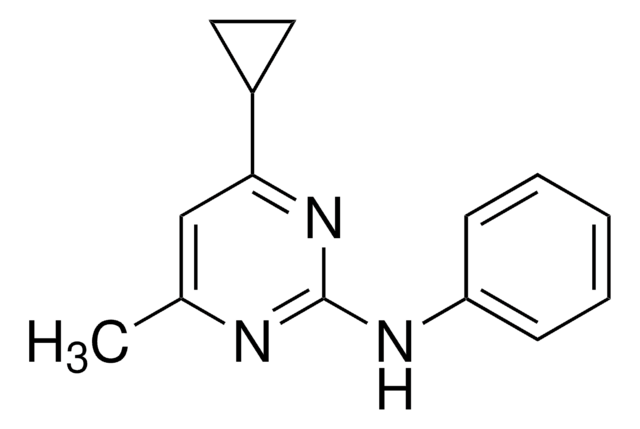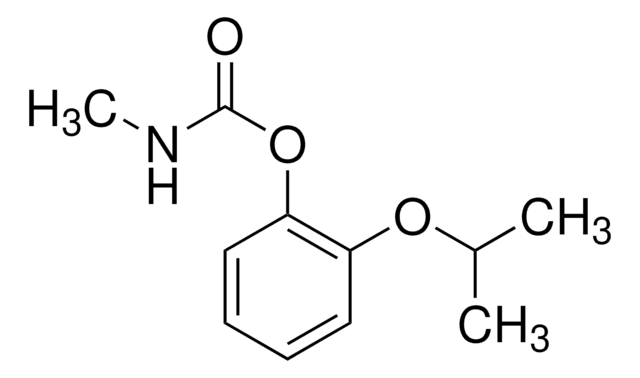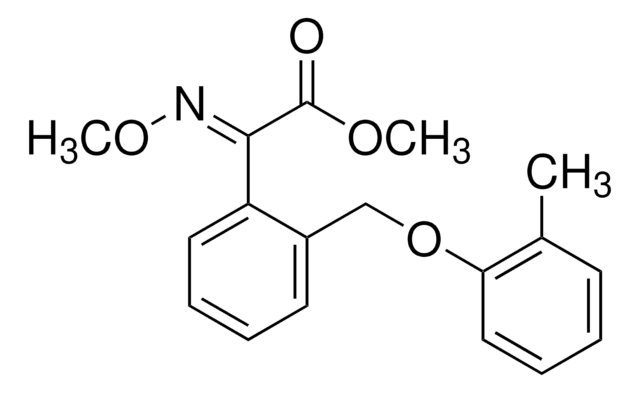46102
Fludioxonil
PESTANAL®, analytical standard
About This Item
Empfohlene Produkte
Qualität
analytical standard
Produktlinie
PESTANAL®
Haltbarkeit
limited shelf life, expiry date on the label
Anwendung(en)
agriculture
environmental
Format
neat
SMILES String
FC1(F)Oc2cccc(c2O1)-c3c[nH]cc3C#N
InChI
1S/C12H6F2N2O2/c13-12(14)17-10-3-1-2-8(11(10)18-12)9-6-16-5-7(9)4-15/h1-3,5-6,16H
InChIKey
MUJOIMFVNIBMKC-UHFFFAOYSA-N
Suchen Sie nach ähnlichen Produkten? Aufrufen Leitfaden zum Produktvergleich
Verwandte Kategorien
Anwendung
- Fludioxonil fungicide in agricultural biotech: Fludioxonil′s effectiveness against the two-component histidine kinase Bos1 in Botrytis cinerea was explored, revealing its binding mode and molecular mechanism. This research underscores its critical role as a fungicide in agricultural biotechnology, providing insights that could lead to improved crop protection strategies (Yin et al., 2024).
- Fludioxonil biochemical research for pathogen resistance: The study on Fusarium species causing soybean root rot examined the genetic basis of differing sensitivities to DMI fungicides, including fludioxonil. This contributes to a deeper understanding of fungal resistance mechanisms, enhancing the development of more effective fungicidal treatments (Zhang et al., 2024).
- Fludioxonil antifungal properties in plant disease control: Research characterized fludioxonil and phenamacril dual resistant mutants of Fusarium graminearum, highlighting fludioxonil′s critical role in managing resistance in pathogens and its ongoing relevance in managing crop diseases (Wen et al., 2024).
Rechtliche Hinweise
Signalwort
Warning
H-Sätze
P-Sätze
Gefahreneinstufungen
Aquatic Acute 1 - Aquatic Chronic 1
Lagerklassenschlüssel
11 - Combustible Solids
WGK
WGK 2
Flammpunkt (°F)
Not applicable
Flammpunkt (°C)
Not applicable
Persönliche Schutzausrüstung
Eyeshields, Gloves
Analysenzertifikate (COA)
Suchen Sie nach Analysenzertifikate (COA), indem Sie die Lot-/Chargennummer des Produkts eingeben. Lot- und Chargennummern sind auf dem Produktetikett hinter den Wörtern ‘Lot’ oder ‘Batch’ (Lot oder Charge) zu finden.
Besitzen Sie dieses Produkt bereits?
In der Dokumentenbibliothek finden Sie die Dokumentation zu den Produkten, die Sie kürzlich erworben haben.
Kunden haben sich ebenfalls angesehen
Unser Team von Wissenschaftlern verfügt über Erfahrung in allen Forschungsbereichen einschließlich Life Science, Materialwissenschaften, chemischer Synthese, Chromatographie, Analytik und vielen mehr..
Setzen Sie sich mit dem technischen Dienst in Verbindung.
















